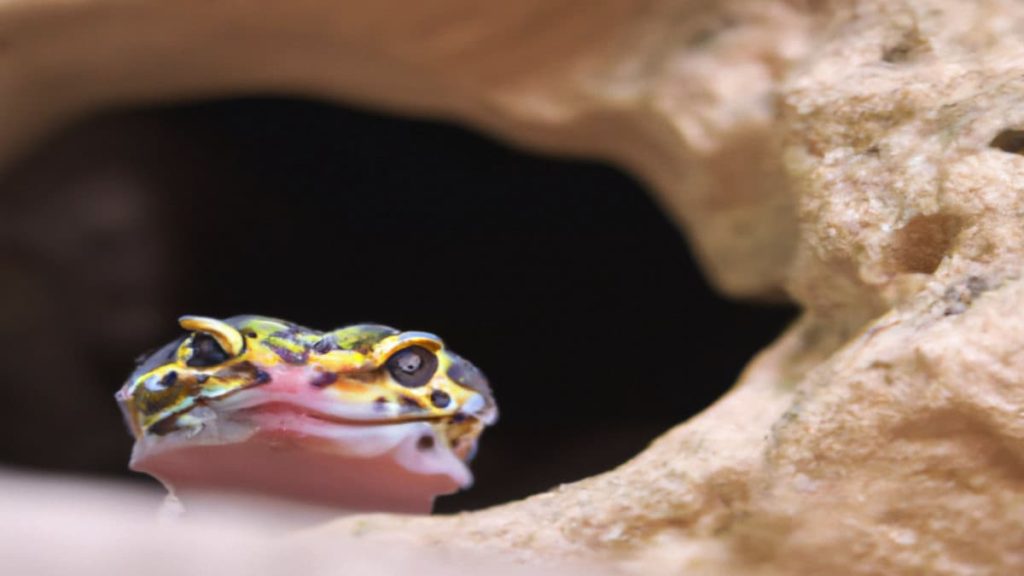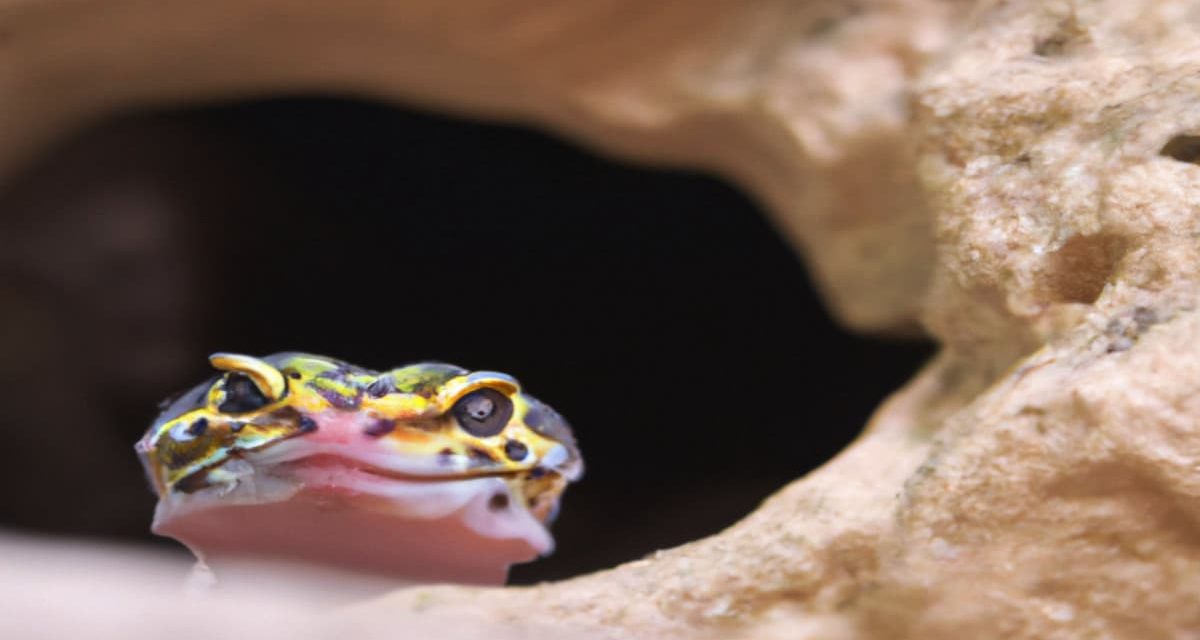
Get The Quick Facts:
- Leopard geckos are naturally solitary creatures, and should not be kept together in the same enclosure as it goes against their asocial species nature and evolutionary instincts of competition.
- Gender is the biggest factor when considering leopard gecko cohabitation. Male and female geckos should only be housed together if a breeding program is planned. Males and males, and females and females should never be housed together, as they can become aggressive towards each other and can cause serious injury or death.
- Other factors to consider when putting two leopard geckos together include their relationship and history, as well as the size of the enclosure and available resources. If keeping leopard geckos together, it is important to closely monitor their behavior and separate them if any signs of aggression or stress occur.
Introduction
Leopard geckos are popular pets, but can they live together? It is important to understand their social behavior and housing requirements. Leopard geckos are solitary animals and may become aggressive towards each other if forced to live together. Inappropriate housing can cause stress, disease and even death. Providing adequate space, heat, and hiding places can reduce the risk of territorial fights. It is advisable to house leopard geckos individually to ensure their safety and well-being.
Leopard Geckos Are Naturally Solitary Creatures
As I delved into the world of leopard geckos, I discovered that these fascinating creatures are naturally solitary beings. It turns out that they don’t live in large groups or colonies but instead lead mostly solitary lives. This asocial species is not known for its sociability, and they don’t seem to crave the company of others of their kind. But why are they like that? As I continued my research, I found that the evolutionary instincts of competition may have something to do with it.
Let’s get deeper into what makes leopard geckos naturally solitary creatures.
Asocial Species
Leopard geckos are classified as an ‘asocial species’ which means they do not naturally seek out social interaction with each other. Unlike some social species that require companionship to survive, leopard geckos thrive best when they are left to their own devices. This trait is believed to stem from their evolutionary origins where competition for resources played a significant role in the survival of the fittest.
It is important to note that just because leopard geckos are classified as an asocial species does not mean they cannot cohabit with others of their kind. However, introducing two or more leopard geckos into a shared living arrangement can bring about a wide range of issues and potential health problems if not closely monitored.
Some unique details to consider when attempting cohabitation between leopard geckos include factors such as the relationship and history between the geckos, enclosure size and available resources. Assuming these factors are met, gender is still the most significant influencer on whether or not leopard geckos can coexist without harming one another.
Leopard geckos may be cute, but their evolutionary instinct to compete will make them less friendly than a hungry crocodile.
Evolutionary Instincts of Competition
Leopard geckos possess a natural tendency for the evolutionary instincts of competition, which means they are predisposed to competing with other leopard geckos for resources like food and prime basking spots.
As such, it’s important to note that these instincts have enabled their survival as a species for over 60 million years. Therefore, introducing multiple leopard geckos in the same enclosure can lead to competition and aggression since their instinctual behavior involves isolation.
In addition, leopard geckos are nocturnal creatures that prefer to come out at night and hunt for food alone. It implies that keeping them in groups will prevent them from carrying out this hunting activity effectively. This behavior would cause conflicts between individuals since they may try to hunt multiple times simultaneously.
It is necessary to note that even if there is enough available space in an enclosure, leopard geckos may still compete due to their territorial nature.
Numerous facts make it impossible or challenging for leopard geckos to coexist peacefully with one another.
However, suppose one cannot avoid cohabiting two leopard geckos due to various reasons like saving money on buying multiple enclosures or because both animals share a strong bond or breeding purposes. In that case, it’s best to ensure they are gender-compatible and monitor closely despite having separate hiding spaces and basking areas.
Leopard geckos agree: bros before hoes, or in this case, males before females.
Gender Is The Biggest Factor In Leopard Gecko Cohabitation
As an experienced leopard gecko owner, I know that many people wonder if it’s possible to keep multiple geckos in the same enclosure. After researching and speaking with experts, I’ve found that gender is the biggest factor in determining whether leopard geckos can live together (here’s How To Tell The Gender Of A Leopard Gecko).
In this section, we’ll explore the different types of gender pairings and options for leopard gecko cohabitation. We’ll discuss the common challenges that arise with cohabitation and provide tips for ensuring the health and safety of your leopard geckos.
Male and Male Cohabitation
Leopard geckos are naturally solitary creatures and asocial species. Due to their evolutionary instincts of competition, male and male cohabitation is not recommended as it could lead to physical harm or even death. In addition, territorial behavior can trigger stress and aggression among males. If cohabitation is necessary, a larger enclosure with ample hiding spots will improve the chances of a peaceful living arrangement. It’s better to ensure space requirements for each gecko rather than risking potential harm.
Pro Tip: Always monitor your leopard geckos when introducing them to each other and separate them immediately if you notice any signs of aggression or discomfort.
Putting two female leopard geckos together is like trying to fit two queens in one castle- it’s a recipe for disaster.
Female and Female Cohabitation
Leopard geckos being solitary creatures, their female and female cohabitation is not recommended. It poses various risks including territorial aggression and domination issues. In the wild, these geckos prefer living alone only coming together to mate. Cohabitating them can lead to stress and lower life expectancy.
In the case of leopard geckos, females are generally more aggressive towards each other leading to dominance battles even if provided with enough food and space. This can lead to injuries or even death for the weaker or submissive gecko. Female leopard geckos also show increased levels of stress hormones when housed together leading to health issues such as decreased appetite, skin discoloration, etc.
It’s important to note that female and female cohabitation isn’t recommended in many reptile species as it does little good but rather poses more risk for their well-being. Keep in mind that if you’re planning on housing your female leopard gecko with another one for longer periods, it’s best not to.
Pro Tip: Avoid leopard gecko cohabitation unless you have a breeding pair and a clear understanding of proper care requirements for both individuals involved.
Putting a male and female leopard gecko together may seem like a great idea until you realize you’re basically setting up a reptilian Tinder.
Male and Female Cohabitation
Leopard geckos of opposite genders should be kept together only for the sole purpose of breeding. Cohabitation imposes significant risks on both geckos in terms of stress levels, as well as potential physical harm from fighting. Males can be territorial and aggressive towards females, sometimes leading to injuries or even death if a smaller female is paired with a larger male. It is essential to provide ample space for two leopard geckos and ensure that there is enough hiding spots and feeding areas to prevent potential disputes.
Pro Tip: Always supervise leopard geckos when first introduced to one another and have a backup plan in case they are incompatible.
Before playing matchmaker with your leopard geckos, consider their past relationships and available real estate – it may not be a love match made in lizard heaven.
Other Factors To Consider When Putting Two Leopard Geckos Together
As someone who’s interested in caring for leopard geckos, it’s essential to weigh all the factors before putting two of them together. One of the primary considerations that come to mind is their relationship and history. Are they from the same clutch or have they never met before? Examining this factor and others like it may help you determine whether two leopard geckos can make suitable cage mates.
Another important consideration is the enclosure size and available resources. This can directly impact the living conditions and overall health of your pets, so it’s crucial to get it right. Let’s take a closer look at these factors to help you make an informed decision about your leopard geckos’ living arrangements.
Relationship and History
Leopard geckos’ relationship and history are crucial factors to consider when cohabiting. If two leopard geckos have previously lived together, it may not guarantee a happy future. Conversely, placing two unfamiliar geckos in the same enclosure is likely to create stress and aggression between them.
It’s essential to introduce the two geckos gradually, especially when they’re unfamiliar with each other. Placing them in an enclosed carrier or container can allow for scent exchange, allowing both geckos to get used to each other’s smell. The location where the introductory process takes place should be neutral territory for both geckos and free from any possessions that either of the animals claim as their own.
It’s recommended that keepers avoid cohabitating leopard geckos altogether due to leopards’ solitary nature. When setting up multiple enclosures adjacent to one another, access holes that separate them completely are essential. This way, no physical contact can occur between individual lizards through holes or glass walls, further reducing chances of bickering or damage being caused by over-competition over available resources.
Make sure your geckos have their personal space or they might end up fighting for the last cricket in town.
Enclosure Size and Available Resources
To ensure the successful cohabitation of leopard geckos, considering enclosure size and available resources is crucial. The following table summarizes the appropriate requirements for successful cohabitation of leopard geckos in terms of enclosure size and available resources:
| Enclosure Size | Available Resources |
|---|---|
| Minimum of 20-gallon terrarium | Multiple hiding places and basking areas |
| Additional space for every added gecko | Separate food dishes and water sources |
| Careful monitoring of temperature and humidity levels | Avoidance of overcrowding |
It’s important to note that while providing enough space and resources can increase the likelihood of peaceful coexistence, it’s still not recommended to keep multiple leopard geckos together due to their naturally solitary tendencies.
Pro Tip: If you do decide to cohabitate leopard geckos, carefully monitor their behavior and separate them if you see any signs of aggression or competition.
Conclusion: Avoid Cohabitating Leopard Geckos
Leopard geckos should not be kept together in the same enclosure. It is not recommended due to territorial and aggressive behaviors. Cohabitating can lead to injuries and illnesses. Owners should provide a separate living space for each gecko with proper heating, lighting, and substrate. Furthermore, it is important to monitor their health and behavior regularly for any signs of stress or disease. Remember, the well-being and safety of the geckos should be top priority.
Some Facts About Whether Leopard Geckos Can Live Together:
- Leopard geckos are naturally solitary and territorial creatures.
- Male leopard geckos will often fight with each other- sometimes to the point of fatal injury.
- Female leopard geckos have a higher chance of getting along when paired together, but conflicts over resources can still occur.
- Combining male and female leopard geckos can lead to reproduction, so this should only be done intentionally for breeding purposes.
- Enclosures for cohabiting leopard geckos require multiple areas for hiding, basking, staying cool, and eating to limit opportunities for fighting over resources.
FAQs about how many leopard geckos can live together
Can Leopard Geckos Live Together?
Leopard geckos are naturally solitary and territorial which means it’s rarely a good idea to have them live together. Some female pairs can live together but it’s not uncommon for male leopard geckos to fight each other- sometimes to the point of fatal injury. In general, it’s best to avoid cohabitating leopard geckos.
How Many Leopard Geckos Can Live Together?
Even though it is possible in very specific situations, cohabitation should be reserved for the more experienced keepers and only when pairing two females.
Can You House Leopard Geckos Together?
While female leopard geckos can sometimes live together, it’s not recommended to house leopard geckos together. Male leopard geckos are territorial and often fight to the death, regardless of whether they grew up together or not.
Can You Put Two Leopard Geckos Together?
It’s not recommended to put two leopard geckos together, particularly male leopard geckos. As naturally solitary creatures, they may view each other as a threat to their survival and fight over resources.
Can Leopard Geckos be Housed Together?
Leopard geckos can be housed together if they are female and carefully monitored to ensure they have plenty of resources to reduce the chance of conflict.
Can You Have 2 Leopard Geckos in One Tank?
You can have two female leopard geckos in one tank, as long as you have a large enough enclosure and plenty of resources available for each gecko. However, it’s not recommended to house male and female leopard geckos together unless the intention is to breed them.













